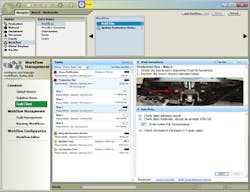GE Fanuc Intelligent Platforms Ups Ante in Manufacturing Software Market
In a move to counter the software challenge laid out by competitors, GE Fanuc Intelligent Platforms, a Charlottesville, Va.-based unit of GE Enterprise Solutions, on March 18 announced Proficy Workflow, powered by the new Proficy SOA (Service Oriented Architecture). Proficy Workflow is designed to provide an industrial Business Process Management (BPM) solution that digitizes and streamlines production processes—from work instructions and standard operating procedures to corrective action and Hazard Analysis and Critical Control Points (HACCP) monitoring.
By establishing an SOA platform, GE Fanuc moves its manufacturing software into the same realm as SOA-based manufacturing solutions such as Archestra, from Wonderware, a Lake Forest, Calif.-based unit of Invensys, and FactoryTalk, from Rockwell Automation Inc., Milwaukee. GE Fanuc is also upping the ante by adding one of the latest technologies from Redmond, Wash.-based Microsoft Corp.—the Workflow engine.
“Proficy Workflow brings the power and results of BPM to the industrial environment,” said Erik Udstuen, GE Fanuc’s Software General Manager. “As one of the world’s largest and most innovative manufacturers, GE can help companies deliver BPM to production operations and drive three key initiatives: integration—coordinating processes across the enterprise; digitization—driving processes electronically; and finally Lean [Manufacturing]—defining a process improvement framework for business transformation.”
Built on an SOA platform, Proficy Worfkflow integrates information and services on a “Plant2Enterprise” basis, adding value to all existing enterprise resource planning (ERP), manufacturing execution systems (MES) and human-machine interface (HMI) systems. Companies can integrate business and production processes across systems and departments for reliable, repeatable process execution. Additionally, the software provides for the integration of people and their functions, or roles, allowing for customization to individuals’ work styles and decision-making. With improved integration, production teams can manage and audit work processes more effectively and consistently.
Logical path
“A key tool that will enable today's plants and factories to realize [the] strategy for operational excellence is the ability to define the process or workflow steps required to achieve a logical execution path,” said Craig Resnick, research director with ARC Advisory Group Inc., Dedham, Mass. “Proficy Workflow appears to meet this criteria of a tool that will help move manufacturers, processors and original equipment manufacturers (OEMs) to a single environment where the existing systems are connected and interacting with each other to maximize the information value of each asset, which will positively impact plant and factory productivity and profitability.”
As an industrial BPM solution, Proficy Workflow takes a production “flowchart” and digitizes it, connecting the people, materials, equipment and systems involved in the work process. Unlike BPM in the enterprise—which operates in hours and days—industrial workflow operates in a time window of seconds and subseconds.
“Proficy Workflow enables companies to achieve a responsive, data-driven, event-based production management strategy,” said Greg Millinger, Workflow/SOA Product Manager for GE Fanuc. “By digitizing processes with industrial workflow, users can capture process, traceability and quality data, drive Lean initiatives based on factual information, and close the loop for production improvement.”
Patent pending
Based on patent-pending workflow execution models and featuring the latest in intuitive graphical interface designs, Proficy Workflow can solve a broad spectrum of production challenges. Workflows can involve basic tasks such as asking an operator to check tank levels every hour, to managing an entire production process, to orchestrating data transformations between ERP and MES. The workflow system can touch almost all production personnel, including quality managers and quality technicians, maintenance, operations supervisors, industrial engineers and others.
The architecture is built upon Microsoft Windows Workflow Foundation—a .Net Framework 3 technology that provides a consistent development experience with other such technologies including Windows Communication Foundation and Windows Presentation Foundation. It includes a programming model, engine and tools for building workflow-enabled applications on Windows.
Common use cases include: orchestrate high-level processes and manage the data between systems; digitize Good Manufacturing Practices (GMP) tasks; digitize Standard Operating Procedures and work instructions; HACCP monitoring procedures and corrective action; alarm and event response corrective action; manual assembly error-proofing; plant task management; decision wizard; and line, workcell and machine setup.
To accommodate exchange and storage of data, Proficy Workflow and Proficy SOA comply with the latest industry standards, including BPEL (Business Process Execution Language) and ISA95. The software follows ISA95 standards for a common framework and data model in which different systems can communicate and give context to data found in static and real-time systems. Once standard data models are in place, workflows can use the data within the models to carry out their execution and have a place to store results of execution.
GE Fanuc Intelligent Platforms
www.gefanuc.com
About the Author
Gary Mintchell
Editor in Chief

Leaders relevant to this article:
